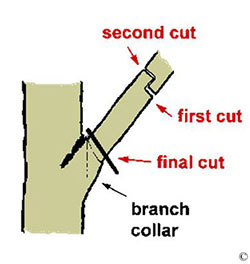If a tree was planted properly in the best location, it should need little or no pruning. However, trees do not always grow as we imagined them to grow. Perhaps a branch is rubbing the house, or two trees grew wider than expected, and now the branches hit each other.
Is pruning trees safe?
Pruning large trees is a safety issue, so hiring a certified arborist may be best way to deal with that cottonwood that overwhelms your backyard – and the neighbors’ yards. Look for local arborists at the International Society of Arboriculture (ISA) at www.isa-arbor.com
When should I prune trees?
Light pruning to remove a few small branches can be done at any time. More extensive pruning should be done in late winter/early spring, unless you have a sappy tree, like maples or fruit trees. Often it is necessary to prune trees when they are fully leafed out, so you can see where and how much to cut.
Most trees can be pruned at any time of the year. Some exceptions are American elms and crabapples which should be pruned in the winter to abate disease spread. Aspen, silver maples, birch and walnut trees exude sap if pruned in the later winter or early spring, but this will not harm the tree.
Why should I prune trees?
Pruning can be thought of as cleaning – broken, dead or diseased branches, and those touching the ground, should be removed. Removing diseased branches can prevent further spread of disease. Overlapping or rubbing branches can introduce infection, so one or both should be removed. It is important to keep branches away from the sidewalk and street, where they are hazards. Weak and soft-wooded trees, like maples, should be thinned periodically to keep snow from breaking the branches and causing major damage.
How should I prune my trees?
When pruning trees, be sure to use the proper tools, and be sure that they are all in good condition. Hand pruners are useful for branches less than one-half an inch thick. Loppers should be used for branches one to one-and-one-half inches in diameter. For limbs up to 20 to 30 feet high, use pole pruners or extension saws. Hand saws are popular, and can be useful for many different plants. Never remove more than one-third of a tree canopy during one season. Dead and dying wood can always be removed, but do not prune too much of the live wood.
How do I remove my prunings?
Use extreme care when pruning with a power chain saw. Avoid power tools not specifically designed for pruning. Consider professional help for pruning larger trees.Local trash companies will usually pick up branches if they have been bundled and tied with twine. Local yard waste recycling centers often accept tree branches and turn them into mulch which residents can get later, often for free.
Refer to Garden Notes 612, 615, and 617, which show “how to” steps for pruning.
YouTube Video
For more information, see the following Colorado State University Extension reference materials at:



